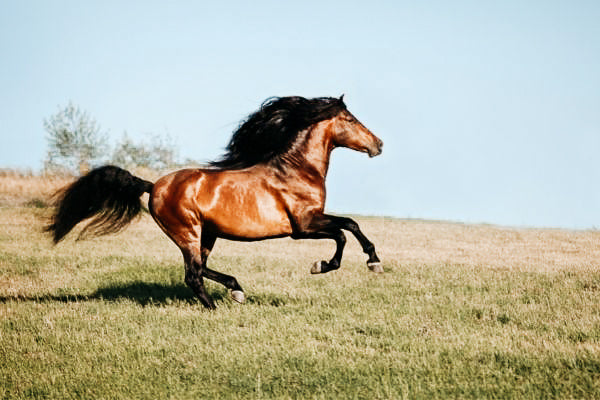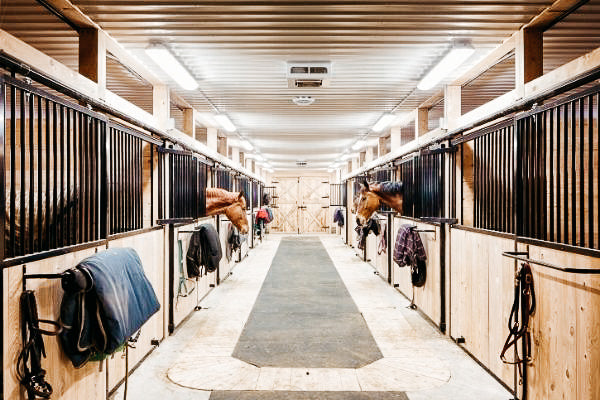
Andalusians – Iberian beauties with class
Iberian horses are considered the main ancestors of every horse breed, along with the Arabian and Berber. Their popularity is therefore increasing far beyond national borders.
As a horse veteran, the Andalusian was able to leave his mark on so many horses. And in fact, for many horse lovers, he is the epitome of dressage grandeur. You are probably familiar with the Spanish Riding School. Riders and Spaniards show their skills with fascinating elegance and inspire the spectators with fantastic teamwork.
We would be happy to explain to you what makes these proud steeds so special in our portrait.
Andalusians - definition and history
Sure, when we hear the word Andalusian, everyone immediately thinks of the beauties of the Spanish Riding School. Fundamentally correct, but also other horses from the Iberian Peninsula e.g. b PRE-Mixes or Lusitanos can be called Andalusian. So it is more of an umbrella term for Spanish horses than a separate breed.
However, if they are bred in pure blood, as is the case in Jerez de la Frontera, for example, these animals are given the name PRE (Pura Raza Española). A monastery was founded there by Carthusian monks in 1476. The pure breeding of the so-called Carthusian PRE's (Cartujanos) is thanks to these. A particularly noble sub-breed of the PRE.
The Pura Raza Española as well as other Spaniards are descended from Sorraia horses. Arabs and Berbers refined them.
As described above, the focus of breeding was on the Carthusian monastery. Nobles financially supported this high-quality breeding. In the early days of breeding in Spain, the PRE's and Lusitanos were kept in a common stud book. In 1967 this split. In addition, in 1989 a special book was created for the black PRE's (Menorcans). It was previously also listed as a sub-breed of the PRE.
There are many breeders in Spain today. The talented dressage and leisure horse is the embodiment of honor and joy of life. People are proud of their beautiful animals. And everyone has their own brand. Mixes such as the Tres Sangres are also popular. As the name suggests, originated from the Arabian, Andalusian and the English Thoroughbred.
1883 was the year in which the Fjord horse was first introduced at an agricultural exhibition in Germany. The Norwegian pony was not consolidated until 1907. Pure breeding became an integral part of Norwegian breeding organizations. As with many horse breeds, the population declined significantly due to mechanization.
In Germany, pure breeding only began in 1954. The animals were “discovered” as ideal leisure horses and the lighter, more rideable Norwegian type was carefully selected. The pretty Fjord horse was no longer just a business horse.
The Norwegian association Norsk Hestesenter keeps the original mare book. Their breeding regulations are also binding for German breeding facilities.
External appearance
Finally. This is where we wanted to go, right? Because visually, the Andalusian horse breed is simply a treat. Let's affectionately call them "Barbie horses". And why? Of course, because of their beautiful, long manes and the magnificently thick tail. Who doesn't have their fingers itching to care for and braid these?
But it's not just the long hair of a Pura Raza Española that is attractive. Their dry head with a broad, rectangular forehead, lively eyes and large nostrils are remarkable. It continues with an extraordinarily well-shaped, very muscular neck.
His arch towards his rounded withers is breathtaking. The back and lumbar areas are also well muscled. The sloping croup, which is further emphasized by the low-set tail, is typical. Strong cane legs, elastic pasterns and compact, good quality hooves harmoniously round off the presentable overall package. A baroque horse body in perfection.
The characteristics of the noble horse breed
When breeding the Iberians, conscious emphasis was placed on impeccable character. Despite their inherent temperament, the horses are honest and manageable. They impress with a high degree of obedience and form very close bonds with their rider. The Spanish Riding School can tell you a thing or two about it. Their stallions are connected to their caregivers for life. The path from foal to dressage horse runs hand in hoof, so to speak.
Iberian horses - suitability
Back then used as a war and hunting horse, today the suitability of these beautiful animals varies. Of course, due to the high level of rideability and ability to gather, becoming a dressage horse or show horse is the top priority for many people. But the Iberian also looks great in front of a carriage, with cattle or as an upscale leisure horse.
This horse breed is still used today as a bullfighting horse because of its courage and willingness to work. In the arena you will enchant spectators with your agility and loyalty to your bullfighter.
Whether the “whole framework” is tasteful remains to be seen. Unfortunately, it's just tradition there. Let's rather enjoy the expressive dressage horse from the riding school, which manages to capture the viewer's gaze in no time.
Caballo de baile - dancing horse
It is not for nothing that people have always decorated themselves with this horse breed. Their powerful, dancing performance and majestic appearance make them absolute dream horses.
Whether in the large arena, at imaginative show events or as a beloved leisure horse - the Andalusian horse has been ready to go his way with "his" people since royal times.
Animalons brush recommendation for the Andalusian:
For an even more glamorous appearance of this graceful horse breed, we recommend our Care Flex shine brush with goat hair. It gives your pet's fur the perfect finish.
In addition, our mane and tail brush is ideal for combing and brushing long and wavy manes and tails.
Discover more posts

Throat blockage in horses – immediate help counts!
Many illnesses require quick action from the owner and veterinarian. Blockage of the throat is one of these emergencies and you should not wait here. In fact, this condition is quite...
Continue reading
Changing stables – useful tips to avoid stress
In the lives of you and your horse, it can happen from time to time that you change stables. Be it that you have to move for work, the stable operator is closing due to age or health reasons, ...
Continue reading
